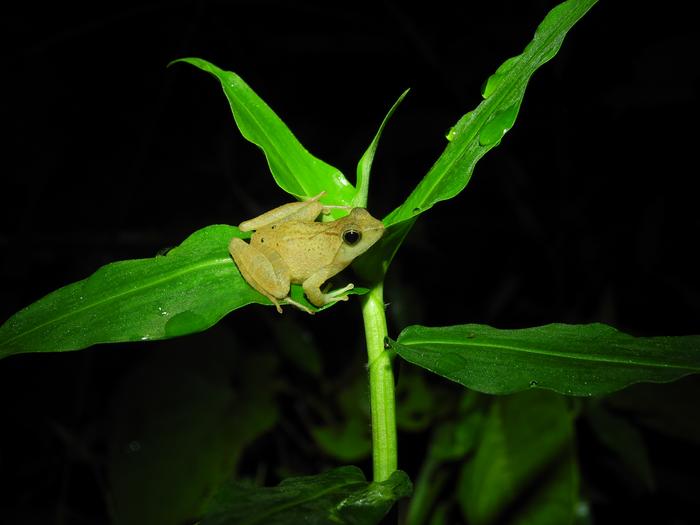Even widespread species could be genomically vulnerable to the climate crisis, scientists warn. By studying the DNA of puddle frogs living in central African rainforests, the scientists found that areas of high environmental variation foster high genetic variation. If these varied habitats and the frogs that live there are lost, genetic variants that could have allowed the species to evolve to survive the climate crisis could be lost too. Meanwhile, populations with low genetic variation could become extinct quickly, unable to adapt.

Credit: Dr Hilton Oyamaguchi
Even widespread species could be genomically vulnerable to the climate crisis, scientists warn. By studying the DNA of puddle frogs living in central African rainforests, the scientists found that areas of high environmental variation foster high genetic variation. If these varied habitats and the frogs that live there are lost, genetic variants that could have allowed the species to evolve to survive the climate crisis could be lost too. Meanwhile, populations with low genetic variation could become extinct quickly, unable to adapt.
“Generally, the more genomic variation within a population, the more likely they will be able to respond to changes in their environment, such as future climate change,” said Dr Courtney Miller of the University of New Orleans, lead author of the study in Frontiers in Conservation Science.
“We wanted to identify drivers of genomic variation and how populations might respond to future climate change,” added Dr Geraud Tasse Taboue of the University of Buea, second author.
Survival of the fittest
The climate crisis is expected to change the face of the world very rapidly. If animals can’t find suitable habitats, they will need to adapt, either by evolving or by making behavioral changes. The more genetic diversity in a species, the more likely it can successfully evolve to survive.
The tropical forests of the Gulf of Guinea and the Congo Basin are predicted to be particularly seriously affected by the climate crisis. These forests are also biodiversity hotspots. Several factors could contribute to this, by separating populations of a species from each other so that they become more distinct over time: distance, physical barriers like large rivers, environmental variation, and fragmentation of the forest during the Pleistocene. A widespread species like puddle frogs makes an ideal model for unravelling the impact of these factors on genetic variation, which is critical to understanding species’ genomic vulnerability — how likely it is that they will be able to adapt evolutionarily to climate change.
The scientists sampled 191 frogs across a range of different locations and habitats, extracting DNA and mapping the occurrence of different variants. They then used environmental variables linked to the frogs’ biology and behavior to map differences between the frogs’ habitats: the annual temperature and rainfall and how much these varied across the year, and the amount of precipitation in the coldest quarter of the year. They used projections of how these variables will change with the climate crisis to model the frogs’ future habitat. They also used models of the past climate to understand how habitat availability in the Pleistocene could affect present-day variation.
Habitat hotspots
Combining this data and analyzing it with specialized statistical methods allowed the scientists to identify the most important forces in driving the puddle frogs’ genetic variation and to determine areas where the frogs would be more genomically vulnerable. The team found that for puddle frogs, genetic variation was influenced by the distance between sites but primarily predicted by their environment. Seasonal patterns of precipitation were particularly influential. Landscapes with multiple types of habitat in close proximity also overlapped with areas of high genetic variation.
“Variation in precipitation is the main factor in environmentally-associated genomic variation for this frog,” said Miller. “Frogs that occur within the Cameroonian highlands, the forest-savanna ecotone of south-central Cameroon, across the equator, and from the coast to the interior of Gabon may be more likely to keep pace with future climate change.”
The scientists also identified several areas where frog populations may not have enough genetic variation to be able to adapt to abrupt habitat changes — for example, in southwest Gabon.
The team suggests that these findings, and similar research on different species, could be useful for planning conservation interventions. However, the scientists caution that their analysis only partially captures the frogs’ genetic variation, and that to fully understand the impact of these variants on puddle frogs’ future survival we’ll need to link them to phenotypic traits.
“We weren’t able to identify variants under selection, which might have provided additional insight on adaptive potential,” said Tasse Taboue. “But conservation efforts could focus on preserving areas with high genomic variation, under the assumption that these areas harbor individuals that may be more likely to persist given environmental change.”
Journal
Frontiers in Conservation Science
Article Title
Environmental variation predicts patterns of genomic variation in an African tropical forest frog
Article Publication Date
5-Jun-2024
COI Statement
The author(s) declared that they were an editorial board member of Frontiers, at the time of submission. This had no impact on the peer review process and the final decision.



